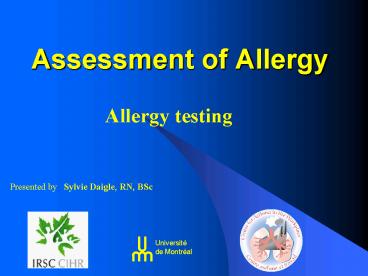Assessment of Allergy - PowerPoint PPT Presentation
1 / 23
Title:
Assessment of Allergy
Description:
Title: Assessment of Allergy Author: Usager Bureautique Last modified by: Usager Bureautique Created Date: 3/23/2006 8:45:05 PM Document presentation format – PowerPoint PPT presentation
Number of Views:234
Avg rating:3.0/5.0
Title: Assessment of Allergy
1
Assessment of Allergy
- Allergy testing
Presented by Sylvie Daigle, RN, BSc
2
Assessment of Allergy
- The term "Allergy"
- Allergic reaction
- Assessment of atopy
- Skin or immunological testing
3
What is Allergy?
- Also known as
- Hypersensitivity
- Disease
4
Definition
- The term allergy ( von Pirquet -1906),
- can be summarized as the acquired,
- specific, altered capacity to react.
- From Greek words allos "change, altered"
- ergon "reaction, reactivity".
- Acquired means prior adequate
- antigenic or allergenic exposure.
5
Allergy has increased
- Incidence of allergy has doubled in the
- last 20-30 years, why?
- Less exposure to parasitic disease?
- Lower rate of breast-feeding ?
- Exposures to air pollution?
- Exposure to allergens in town vs in the country
- The "hygiene hypothesis"?
6
Classification of allergic reaction by Gell
Coombs Type I Anaphylaxis (IgE) Atopic
diseases (immediate) Type II Cytotoxic Autoimmune
hemolytic anemia Type III Immune complex
Farmers lung (IgG) Type IV Delayed allergy
Skin reaction to tuberculin
First published in 1968 Clinical aspects of
immunology
7
(No Transcript)
8
Assessment of Atopy
- Clinical ? essential for asthma management
- (in particular if pets at home, in relation to
the - pollen seasons, etc.)
- Epidemiologic studies
- Occupational investigation
9
Type I Hypersensitivity Detection
- Skin Prick Testing, recommended to assess atopic
status - RAST (ELISA), serum specific antibodies
- Intradermal Skin Testing more sensitive
- than prick testing but less specific, with risk
of anaphylactic reaction also, difficulty of
interpretation (local trauma due to injection)
10
Skin Prick Test
- Widespreaded in the 1970s after its modification
by J. Pepys - Advantages
- Mechanisms
- Technique
- Interpretation
- Factors affecting skin test
11
Relevant allergens (ubiquitous, occupational)
- House dust mite
- Ragweed, tree pollen
- Pets
- Cockroaches
- Molds
- Occupational protein allergens
12
Occupational protein allergens
- Many occupational agents cause asthma by
- sensitization
- mostly high-molecular-weight proteins
- some low-molecular-weight agents
- In the case of high-molecular-weight
- allergens , skin prick tests are the preferred
- diagnostic correlates of Ig-E sensitization
13
- Advantages
- Skin prick testing is cheap, rapid and accurate
- High degree of specificity
- Safe and painless
- Wide range of allergens
- Objective evidence of sensitization
14
Technique and reaction
- Introduction of allergen extract into the dermis
- Ig-E-mediated response
- Allergen-induced wheal-and-flare reaction
15
Technique
- Use the inner forearm
- Mark the area to be tested (2 cm apart)
- Place a drop of each allergen extract on each
mark - Prick the skin through the drop
- Use a new lancet/needle for each allergen
- Negative (saline solution) and positive control
(histamine phosphate, 10 mg/ml) must be included
to exclude false positive reactions
(dermographism) and false negative reactions - (intake of antihistamines)
16
Put drops of allergen
Prick the skin through extracts on the skin
the drop
17
INTERPRETATION
- Read at their peak (15-20 minutes)
- Measure with a millimeter rule
- Largest smallest of wheal and erythema
- 2
- The wheal is principally used (diameter)
- What if the negative control is positive?
- What if the positive control is negative?
- The size of the wheal does not relate to the
severity of symptoms
18
Common errors in prick testing
- Tests too close together (lt 2 cm)
- Induction of bleeding, leading possibly to
false-positive results - Insufficient penetration of skin by lancet
leading to false-negative - Spreading of allergen solutions during the
- tests.
19
- Causes of false-positive skin prick tests
- Irritant reaction
- Dermographism
- Contamination of an allergen extract
- Enhancement from a nearby strong reaction
- Causes of false-negative skin prick tests
- Extract of diminished potency
- Medications modulating allergic reaction
- Diseases attenuating the skin response, e.g.
eczema - Improper technique (no or weak puncture)
20
Factors affecting skin test results
- Quality of the allergen extract (standardized)
- Area of the body, wrist least reactive
- Age, less reactive after 50
- Circadian rhythms do not affect the skin reaction
- Drugs short acting antihistamines inhibit the
wheal-and-flare reaction for up to 24 h long- - acting antihistamines may affect reaction for up
- 4-5 days.
21
CONCLUSIONS
- When properly performed, skin tests
- represent one of the major tools for
- diagnosis of Ig-E-mediated diseases.
- Assessment of the atopic status of subjects
- is often included in epidemiological studies
- of asthma and occupational asthma because atopy
- is a risk factor.
22
Natural history of sensitization, symptoms and
diseases in apprentices exposed to laboratory
animalsD Gautrin, H Ghezzo, CInfante-Rivard, J-L
Malo. Eur Respir J, 2001.
Predictive value of specific skin reactivity for
W-R symptoms
Skin reactivity
PPV 28 30 21 30 9
W-R symptoms Skin Nasal Ocular Nasal and/or
ocular Respiratory
before 21 18 14 17 9
same time 22 17 16 19 4
PPV of W-R RC symptoms for probable OA 11.4
23
references
- - Bernstein IL, Chan-Yeung M, Malo JL, Bernstein
DI. Asthma in the Workplace. Francis Taylor,
2006 - - Middletons Allergy Prinnciples and practice
vol. 1,chap 38. - - Pepys, J. Clinical allergy, 1973, pp 491-509.
- - Pepys, J. Atopy a study in definition.
Allergy 199449 397-399 - - Bernstein DI and al.Characterization of skin
prick testing responses - J Allergy Clin Immunol 1994 49498-507
- Web sites of interest
- - www.asthma-workplace.com
- - www.asthme.csst.qc.ca/document/Info_Gen/AgenProf
/ - - www.remcomp.com/asmanet/asmapro/index.htm































